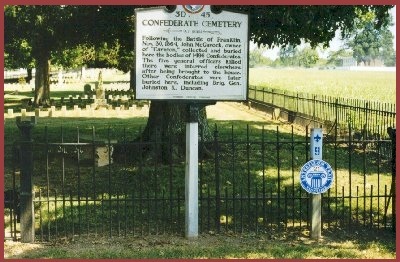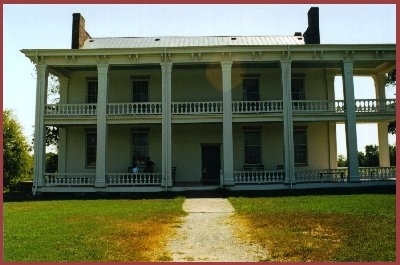Battle of Franklin 1864
Confederate Cemetery – Franklin, TN; photo by James Long
Historical Marker text: “Confederate Cemetery: Following the Battle of Franklin, Nov. 30, 1864, John McGavock, owner of “Carnton”, collected and buried here the bodies of 1496 Confederates. The five general officers killed there were interred elsewhere after being brought to the house. Other Confederates were later buried here, including Brig. Gen. Johnston K. Duncan.”
The following account of the Battle of Franklin appeared in the November 30, 1899, issue of The Williamson County News. The author of the article was listed as “One Of Forrest’s Men”.
The 30th day of November, 1864, was a day forever memorable in the annals of the town of Franklin; for on that day was fought one of the bloodiest battles of the war between the states.
The Confederate Army, after being driven from Dallton, GA., to Atlanta by the force of over-powering numbers, there turned northward again, and after a long and wearisome march, varied by numerous combats with the enemy, reached the Tennessee River, near Florence, Ala., and after several days of preparation, prededed by the “Wizard of the Saddle,” Forrest, and his horsemen, moved to the northern banks of the stream, and then commenced the most remarkable campaign of the late war.
The cavalry under Forrest engaged the enemy the morning after the crossing, and drove them back day after day, till they reached their fortified lines, around Columbia, Tennessee. Here Forrest waited for Hood and his infantry, who arrived the next day, and crossed Duck River above the town, causing the enemy to continue his retreat toward Franklin. At Spring Hill, a place intermediate between Colunbia and Franklin, the enemy narrowly escaped destruction, but by mismanagement on the part of some of the Confederate Generals, the enemy managed to elude the trap laid for them and escaped to Franklin, where, meeting reinforcements, they immediately commenced to cover their front with a strong line of intrenchments, which were barely finished when the Confederate army came in view, marshaled in three lines of battle, with the sturdiness of veterans and the precision of a holiday parade, with bands at the head of the regiments and the burnished arms glistering in the sun of that November day.
On they came, nearer and still nearer, with unbroken front and serried ranks, till at last the rattling fire of skirmishers in front gave notice that the enemy’s advance line was encountered and the great battle was fairly opened.
Catching the site of the enemy in front, the gallant Southern boys, with a ringing cheer that spoke of their determination to do or die, rushed upon the embattled lines before them. One fierce charge, one thundering volley, and the enemy broke from their shelter and sought refuge behind their inner and stronger works. Fast behind them came the Southern soldiers, plying their death-dealing rifles, till the ground between the two lines was thickly dotted with the forms of men in blue. Till now, the Confederates had suffered but little loss, but now, where the fleet-footed enemy had reached their covert, the incoming Confederates received in their very faces a withering and desolating fire from behind the strong works, that piled the ground with dead and wounded men. But still they dashed on, and loud above the roar of battle was heard the historic “Rebel Yell.” On they came, up to the very works, and, in some places, over them. Still they fought till the dimished ranks were beaten back, but only to rally and come again! Again and again they were swept from the faces of the fire-girdled works, only to form and dash back, cheered on by their heroic leaders.
Where they stood, they fought; and where they fought, they fell, and thus, through the waning hours of that November day the struggle went on. Far into the night the charging yell was heard, and the deep-toned thunder of artillery gave token that the combat still raged. The midnight hour had nearly struck before the heroic Southern soldiers desisted from their attack and grimly resting upon their arms, waited for the dawn, to recommence their work of death. And when the gray light of that dawn had come, again advancing, they found the works abandoned and the enemy gone–nothing left to tell of the fearful fight but the mournful heaps of dead and dying, sad mementoes of two shattered armies.
Now, when the excitement of battle was over and men calmly surveyed the scene of yesterday’s fierce combat, the view was terrible. Here lay heaps of dead men and horses; there, great piles of slain filled the ditch, reaching in a gory tangle of limbs and bodies to the very crest of the work; and for some distance in front the ground was so thickly carpeted with the dead that one could scarcely walk without treading upon the lifeless forms.
Here, close up to the line, fell the dauntless Cleburne; there, across the works, lay the horse of Adams, his heroic rider having fallen headlong among his foes. In the very act of mounting, the works fell Strahl; these, with the chival Granberry and brave Carter making six general officers that were lost to the Confederacy on that fatal field, besides some thousands of lesser rank and file of the Southern army.
Canton Plantation – Franklin, TN; photo by James Long
Historical Marker text: The Carnton Plantation was built ca. 1815 by Randal McGavock (1768-1843), planter, political leader and mayor of Nashville. Named after the McGavock home in Northern Ireland, the house was greatly enlarged by Randal ca. 1826. His son, John, later added the Greek Revival porches, one of which served as an observation post for Gen. Nathan B. Forrest during the Battle of Franklin, Nov. 30, 1864. After the Battle, Carnton served as a hospital. The bodies of Generals Adams, Cleburne, Granbury, and Struhl rested on the back porch the next morning. Carnton was acquired by the Carnton Association in 1978.”

